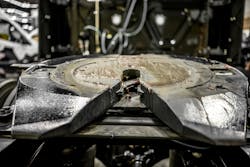Lubrication is an essential aspect of commercial vehicle maintenance. In order to provide adequate and necessary lubrication, a fleet needs to understand the nuances of one of the most important lubricating agents: grease. There is a wide range of greases available today suitable to an even wider range of applications. Understanding what grease to use for each application can help a fleet’s maintenance efforts in assuring vehicles and operations run smoothly.
The composition of grease
Grease can be understood as a mixture of oil, additives, and a thickening agent, referred to as a thickener.
“A lubricating grease is typically composed of 50 to 90 percent base oil, 3 to 5 percent thickener, and 2 to 10 percent additives,” says Ron LeBlanc Sr., senior technical services advisor, Petro-Canada Lubricants. Petro-Canada Lubricants is a developer and producer of lubricants, specialty fluids, and greases.
There exists a wide range of additives used in grease which serve as protective agents.
“[Within a grease formulation,] we have anti-wear additives or extreme pressure additives, antioxidant-type additives to protect the grease under high-temperature conditions, and anti-corrosion additives in the grease as well,” says Stede Granger, OEM technical services manager at Shell, a global group of energy and petrochemical companies.
Thickener serves an important role in a grease. Kuldeep Mistry, product development specialist at Timken, a designer of bearings and power transmission products, compares the role of a thickener to that of a sponge. The concept of a sponge holding water and releasing that water under pressure can apply to thickener in grease, wherein the thickener holds the oil within the grease. When the grease is placed under heat and pressure, the molecules are broken down into smaller pieces, a process known as shear. This process releases the oil to the component for lubrication.
“When the grease is subjected to mechanical work, it releases the base oil and additives to lubricate the components, whether it’s rolling elements of wheel bearings, sliding surfaces of a fifth wheel, et cetera,” LeBlanc says. “When the rolling elements stop and the grease cools, it returns to its original texture. This is called thixotropic behavior.”
Certain thickeners can provide improved shear performance within the grease.
“For the fleet application, you need lithium or lithium complex thickener because they have excellent shear stability,” Mistry continues. “They have very good high temperature performance. This makes a lithium-base grease a great candidate to attain the long lubrication grease life to support the bearing.”
There are many options when it comes to thickening agents within a grease.
“Some thickeners in greases available in today’s market include aluminum complex, lithium, lithium complex, calcium, and calcium sulfonate complex,” LeBlanc says. “Greases can also contain solid lubricants such as molybdenum disulfide, graphite, and others.”
The majority of a grease’s composition consists of its base oil. There are differences between greases utilizing conventional oils or synthetic oils that fleets should be aware of.
According to Granger, the additives for greases with conventional or synthetic base oils would be similar, as well as their viscosity. Often, he suggests, greases that have a mineral base oil cost less.
“The advantages of the synthetic oil over the mineral oil is that the synthetic oils have better cold temperature properties,” Granger continues. “The grease will pump better, operate better, cause less drag, and perform better in cold temperatures.”
It is not only the cold temperature performance that synthetic oils excel in, but high-temperature environments as well.
“The other place that synthetic base oils do better in is [their] ability to handle higher temperatures for longer periods of time,” Granger says. “If the grease is going to be in a hot environment, then the synthetic is a better choice.”
The difference in performance between conventional and synthetic oil can be understood through their respective molecular compositions resulting from their refining processes.
“When we take crude oil out of the ground, it is a mixture of all kinds of different components, and part of the refining process is to separate those components,” Granger explains. “We separate out the lighter molecules from the heavier molecules to make different grades of hydrocarbons. We’re separating the hydrocarbons, but it’s an approximation, so we get a smaller mixture of components. When we create a synthetic base oil, that is typically very pure, and it has the right molecules. As a result, we have components in the mineral oil that don’t do very well at the higher temperatures, whereas the synthetic oil is [comprised of] the molecules that we want that do handle the high temperatures.”
Furthermore, synthetic base oil greases generally have a higher viscosity index (VI). The VI reveals how the oil changes with temperature. The higher the VI, the less the oil changes with temperature. Granger says that Shell includes VI improving additives to conventional mineral oil to avoid drastic changes in varying temperatures.
Grading the grease
The National Lubricating Grease Institute (NLGI) classifies the “grade” of a grease based on its texture. To determine the grade of the grease, the NLGI utilizes a penetration test – ASTM D217. The American Society for Testing and Materials (ASTM) penetration test places a cone over a container of grease and drops the cone into the grease. The cone’s penetration into the grease is measured and the depth of penetration is compared to a reference standard wherein the NLGI assigns the grade of the grease according to the depth of penetration.
“The penetration or stiffness of the grease is a function of the thickener type and the thickener concentration in the formulation,” LeBlanc says. “Although the [NLGI] scale ranges from the softest #000 grade to the stiffest #6 grade, most greases for fleets are between NLGI #00 to NLGI #2.”
LeBlanc explains that heavily loaded, slow speed applications such as a fifth wheel generally require a stiffer grade of grease to properly lubricate. In applications such as trailer wheel bearings, a common grease of choice is a softer, semi-fluid NLGI #00 synthetic base oil grease.
Lubrication and anti-contamination
Simply put, grease lubricates vehicle components. However, depending on its grade, composition, and application, grease can serve a multitude of purposes on the commercial vehicle.
“Grease is a lubricant,” Mistry says. “Its primary goal is to separate the mating surfaces within the bearing or within the engineering component by creating a lubricant film under high contact stresses. The lubricating film helps to reduce the friction, the wear, and prevent corrosion.”
Not only does grease lubricate, but it also seals and protects components.
“Greases are excellent sealants and thus they aid in minimizing contamination,” Mistry explains. “Grease is preferred for equipment operating under extreme conditions, such as high temperature and pressure, or contact stresses, shock loads, as well as slow speed under heavy load.”
Best practices for greasing
A fleet should consult the vehicle owner’s manual or with the vehicle OEM to best understand application recommendations for greasing components. This should present a guide to lubrication intervals per component. This research may or may not reveal how much grease to utilize per application; technicians should proceed with caution, consult with OEMs, consult with lubrication suppliers, and consult the Technology & Maintenance Council’s Recommended Practices to understand the quantity of grease per application to avoid over- or under-greasing.“In a lot of the typical grease applications, you like to put in enough grease until you see it come out a little bit, and you know you’ve filled the joint up,” Shell’s Granger explains. “There are certain applications where you don’t want to do that. If the joint is a sealed joint, you don’t want to put too much grease in there because if it has a rubber boot on it, you can actually damage that rubber boot.”
Applying too much or too little grease can yield component damage, and in some cases cause catastrophic failure.
“Too much grease causes friction within the bearing housing, leading to seal failure due to higher-than-normal temperatures which causes the grease to thin and run out of the bearing,” LeBlanc says, adding that this can also allow contaminants to penetrate the bearing. “When too little grease is applied, the bearing or component can get hot and cause damage. Once a grease starts to get hot, it continues to build heat and takes longer to cool because it is not moving through the component rapidly. Ultimately, the heat builds to a point where the component begins to fail. Sometimes when the component gets hot enough, a catastrophic failure occurs, or a fire breaks out from the heat.”
LeBlanc recommends an automatic lubricator for tough-to-lubricate components in order to increase safety and efficiency.
Fleets and technicians should routinely monitor greased components to ensure proper lubrication has been completed and to spot any damage from mis-lubrication. There are different tools and methods available to monitor such conditions, such as thermal sensing systems, suggests Ean Howard Dickerhoof, application engineer at Timken. “An operator or a technician can use a heat gun to see what temperature the wheel end is operating at,” Dickerhoof says. “Also, hot dots are very common in the industry to see if the wheel end rises above a certain temperature.”
Timken offers hot dots, visual indicators that change from white to black when the wheel end temperature exceeds 250 degrees F, to monitor wheel end temperature and alert the fleet should the components reach unwanted temperatures.
“Nominal temperature for grease is right around 70 degrees Celsius or 160 degrees Fahrenheit,” Dickerhoof continues. “Either 10 degrees Celsius or 18 degrees Fahrenheit, every increment of that, your grease life is cut in half. The higher temperature that you’re running at will further degrade that grease life.”
Storage of grease is another important aspect fleets must monitor.
“Typically, greases can have a shelf life of up to five years,” LeBlanc says. “The softer NLGI grades of #0, #00, and #000 typically have a shorter shelf life of around two years.”
Timken's Mistry provides the following storage recommendations for greases:
- Products should be kept in their original packaging before being placed into service.
- Fleets should not remove or alter labeling.
- Grease should be stored in a manner in which the packaging is not damaged.
- Storage area temperature should maintain a range from 32 degrees F to 104 degrees F (0 degrees C to 40 degrees C).
- Relative humidity of the storage area should be maintained below 60 percent.
- Storing inside is preferred to avoid contaminants such as dust, dirt, and moisture.
- Packaging should be isolated from undue vibration.
Dispensing grease from its container will require specific equipment. Granger recommends that pumping and dispensing systems have adequate pressure to dispense grease from its container, as well as utilizing a follower plate within the container to reduce contamination and reduce waste.
The adage of “greasing the squeaky wheel” is not suitable for an efficient fleet of commercial vehicles. Proper maintenance procedures, adherence to recommended greasing intervals, and due diligence are essential in the effort to increase uptime and keep vehicles moving. When it comes to selecting greases for a fleet, there are many variables to take into consideration; understanding the climate in which the vehicles will be operating, understanding the different components that will require grease, and deciphering the best suited properties for such instances will allow a fleet to successfully acquire the right grease for their business.
About the Author
Tyler Fussner
Associate Editor | Fleet Maintenance
Tyler Fussner is Managing Editor - Community Manager at Supply Chain Connect, part of the Design & Engineering Group at Endeavor Business Media.
Previously, Fussner served as the Associate Editor for Fleet Maintenance magazine. As part of Endeavor's Commercial Vehicle Group, his work has been published in FleetOwner magazine, as well as Bulk Transporter, Refrigerated Transporter, and Trailer-Body Builders.
Fussner's May 2022 print feature 'The dawn of hydrogen trucks' was named the best single technology article in B2B by the judges of the 2022 Folio: Eddie and Ozzie Awards. Fussner was also awarded Silver in the Technical Article category for the Trade Association Business Publications International (TABPI) 2021 Tabbie Awards.
Fussner previously served as Assistant Editor for Endeavor's Transportation Group on the PTEN, Professional Distributor, and VehicleServicePros.com brands.
Fussner studied professional writing and publishing at the University of Wisconsin-Whitewater. He has experience in shop operations, is a Michelin Certified Tire Technician, and a Michelin Certified Tire Salesperson.


